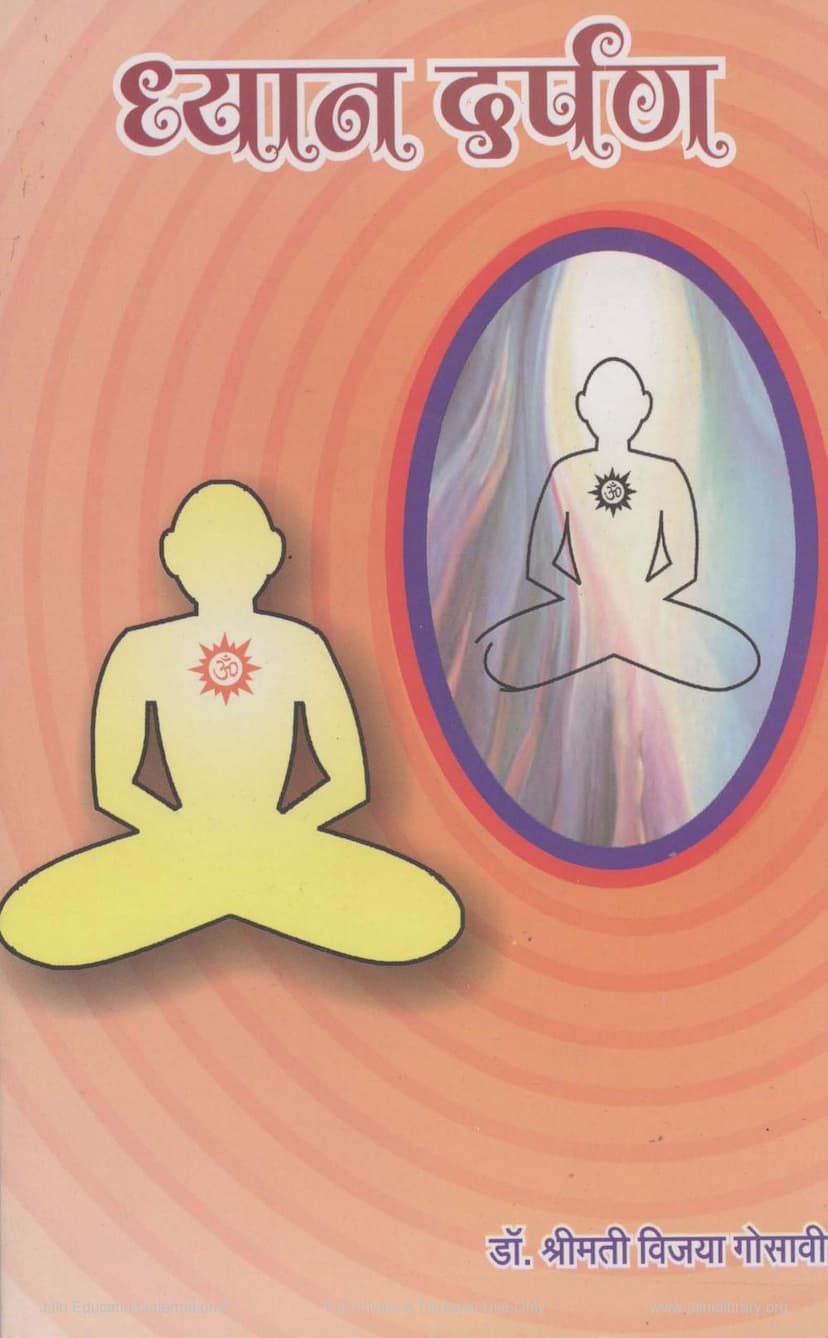Dhyan Darpan
Added to library: September 1, 2025

Summary
"Dhyan Darpan" (Mirror of Meditation) by Dr. Mrs. Vijaya Gosavi, published by Sumeru Prakashan, Mumbai, is a comprehensive treatise on the significance, practice, and philosophy of meditation, particularly within the Jain tradition. The book draws extensively from ancient Jain scriptures and philosophical concepts, aiming to guide the reader towards inner peace and spiritual liberation through the path of meditation.
Core Philosophy and Principles:
- Meditation as a Mirror: The book emphasizes that a mind like a mirror, neutral and reflective, is the ideal state for meditation. When the mind is free from attachment and aversion (rag-dvesh), it can reflect reality without distortion.
- The Path to Moksha: Dr. Gosavi posits that meditation is the gateway to moksha (liberation). By cultivating undisturbed consciousness, one can achieve spiritual freedom. Meditation is presented as the sole means to achieve a thoughtless and tension-free mind.
- Overcoming Modern Stress: The book addresses the pervasive stress of modern life, suggesting meditation as the primary antidote to achieve mental peace and equanimity.
Key Themes and Concepts Discussed:
- The Nature of Meditation: Meditation is defined as the steady focus of the mind on a single, pure object, leading to the cessation of mental fluctuations. It's a journey inward, an exploration of the self beyond the physical and mental planes.
- The Role of Knowledge and Detachment: While meditation is central, it is effectively amplified by knowledge (gyan) and detachment (vairagya). Without these, meditation alone may not lead to the ultimate goal.
- The Importance of the Self: The book strongly advocates for self-discovery and self-realization, asserting that understanding oneself is paramount to understanding anything else. The journey of meditation is an inward pilgrimage.
- Mind and its States: The text delves into the different states of the mind, as understood in Jain, Buddhist, and Yogic philosophies, highlighting the progression from a scattered mind to a concentrated and finally a serene, absorbed state.
- Meditation in Jain Tradition: A significant portion of the book is dedicated to the history and practice of meditation within Jainism. It discusses concepts like Dharmadhyan (meditation on virtue) and Shukladhyan (pure meditation), their stages, and their role in spiritual progress.
- Types of Meditation: The book categorizes meditation into various types, including:
- Inauspicious Meditations (Prashasta Dhyan): Artadhyan (meditation on suffering) and Raudradhyan (meditation on cruelty/anger), which bind the soul further.
- Auspicious Meditations (Aprashasta Dhyan): Dharmadhyan (meditation on Dharma/virtue) and Shukladhyan (pure meditation), which lead to liberation.
- Stages of Meditation: Concepts like Pindastha (meditation on the body), Padistha (meditation on mantras), Rupaastha (meditation on form), and Roopaateeta (meditation beyond form) are explained.
- The "Dhyan Darpan" Methodology: The book introduces "Preksha Dhyan" (insight meditation) as developed by Acharya Mahapragya. This method emphasizes mindful observation ("seeing") of the self, breath, body, and consciousness, fostering detachment and clarity. It details practices like Kayotsarg (body stillness), Antaryatra (inner journey), Shwas Preksha (breath observation), and Lleshya Dhyan (meditation on subtle energies).
- The Physical and Subtle Body: The text touches upon the five bodies (Koshas) and the chakras, linking physical well-being and mental clarity to meditation practices.
- The Soul (Atma) and its Nature: Drawing from Jain philosophy, the book explores the soul as an eternal, conscious, and inherently blissful entity, obscured by karmic coverings. Meditation is the process of removing these coverings to reveal the soul's true nature.
- Inspiration from Great Souls: Dr. Gosavi draws inspiration from various spiritual figures and traditions, including Mahatma Gandhi, Swami Vivekananda, Sri Aurobindo, and the teachings of Mahavira, Rumi, and Jesus, broadening the perspective on meditation.
- Obstacles to Meditation: The book candidly discusses common obstacles such as illness, laziness, distraction, doubt, desires, and lack of interest, offering practical advice on how to overcome them.
Author's Journey:
The book also provides a personal narrative of Dr. Vijaya Gosavi's spiritual journey. Her quest for truth, her religious upbringing, her experiences in America, and her subsequent deep dive into yoga and Jain philosophy, culminating in her Ph.D., highlight the personal dedication and transformative power of meditation.
Overall Message:
"Dhyan Darpan" serves as a guide for anyone seeking inner peace, stress reduction, and spiritual growth. It emphasizes that the path of meditation, rooted in self-awareness, detachment, and consistent practice, is accessible to all and leads to the ultimate realization of the self and liberation from suffering. The book's simple language makes complex philosophical ideas understandable, encouraging readers to embark on their own journey of self-discovery through meditation.